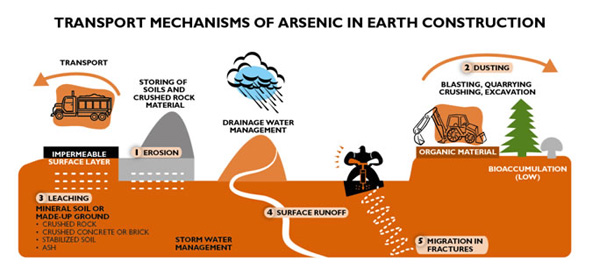Construction

Generalised guidelines for construction and the related exploitation of aggregates in areas with elevated arsenic concentrations
Elevated concentrations of arsenic in soil and in bedrock should already be taken into account in regional or detailed planning. In order to provide adequate information for land-use planning and decision making, cities located in the arsenic-containing areas need systematic information on the regional distribution of arsenic. The local arsenic risk map and associated measures can be included in the local building code.
Construction can involve the excavation of arsenic-containing soils and small-scale production of aggregates with elevated arsenic concentrations. The potential risks of construction and aggregate production to the environment can be identified on the basis of a conceptual model that describes how arsenic can be spread from the production site to the surrounding areas and what the potential exposure routes are. If necessary, two conceptual models can be defined: one for the construction period and one for the built environment.
On construction sites, the toxicological risks comprise the following three components:
- Source: Arsenic at the construction site: Rock or soil types or geological features such as cracks, veins or dykes or aggregate products stored on site and containing elevated arsenic concentrations.
- Pathways: Possible transport of arsenic to and with surface water, groundwater or air dust.
- Recipients: Important groundwater reservoirs, vulnerable species in receiving water bodies, human beings etc.
An accurate and comprehensive conceptual model is helpful in the selection of the necessary sample types, analytical methods and scenarios for risk assessment, and in the identification of potential risk management tools. Sometimes, aggregates with elevated arsenic concentrations can be utilized on site if all transport routes such as direct contact with arsenic-containing topsoil or transport by surface waters is preventable.
The following reports developed for aggregate production can also be useful for construction sites.
Read more at:
- Report: Preliminary risk assessment for rock aggregate production and construction sites - Building a Conceptual Site Model and defining worst case scenarios Download pdf
- Report: Risk assessment and risk management tools Download pdf
- Report: Sampling and analysis Download pdf




